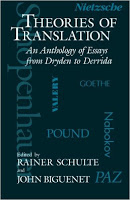

| Online: | |
| Visits: | |
| Stories: |

| Story Views | |
| Now: | |
| Last Hour: | |
| Last 24 Hours: | |
| Total: | |
On the Intent of Translating
I'm fascinated by the assertion in Walter Benjamin's “The Task of the Translator” (in Theories of Translation) that “No poem is intended for the reader, no picture for the beholder, no symphony for the listener.” Is this a philosophic contemplation, or the writer's belief of the highest state of art, or his belief of reality? He seems to be using this as a premise to derive a conclusion that, because the original art doesn't take the receiver into consideration, the translation can't either.
However, there exist several different approaches to translation, as pointed out in “On the Different Methods of Translating” by Schleiermacher. As far as I can tell, the need for more than one approach arises precisely due to the consideration of the receiver. Creation of art, in my view, is complete only after the receiver receives the art. In other words, art is co-created by the author and the receiver. Without the receiver, there is no art.
I would think that, in most cases, the aimed readership dictates the translation method. One example I'd like to cite is the Chinese translation of Finnegans Wake, which I've talked about before. I was visiting China when the translation was published, and I went to a bookstore to see what the book looked like. On each page there are more footnotes than text proper. This, clearly, is not meant for casual readers. The translator said in an interview that “I thought my readers would be scholars and writers.” In this example, a scholarly, academic style was chosen. When I translate Chinese literature into English or vice versa, I would definitely consider my target readership's cultural exposure in regard to the source language. Is this not the right way to approach a translation?
Even were I to accept Benjamin's premises for art and literature in general, the above example convinces me his conclusion does not apply to translation. While translation is a creative and artful process, the very act of translation requires that the art has already been received. Moreover, the people who receive the translation want to do so often because they believe there is something special, based on the reactions of others who have already received it. A key motive of the translator is to have translation receivers share the experience, though necessarily in approximation, of the direct receivers, whether it be lyrical, sensual or intellectual (or all three).
So even if Benjamin is right about art, his claims do not seem to translate. ð
Source: http://insideoutchina.blogspot.com/2017/03/on-intent-of-translating.html



